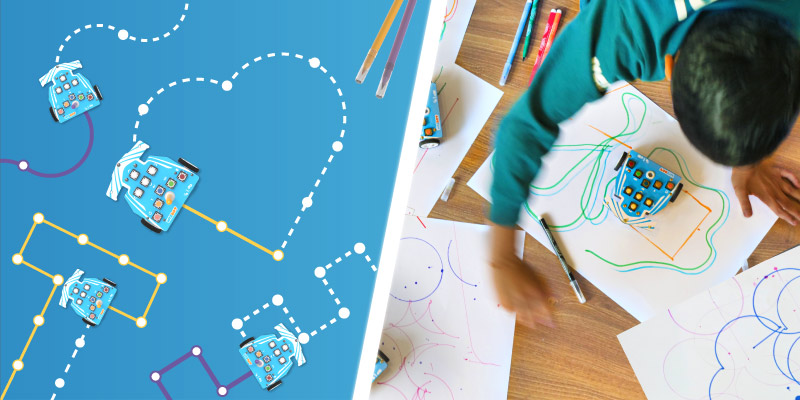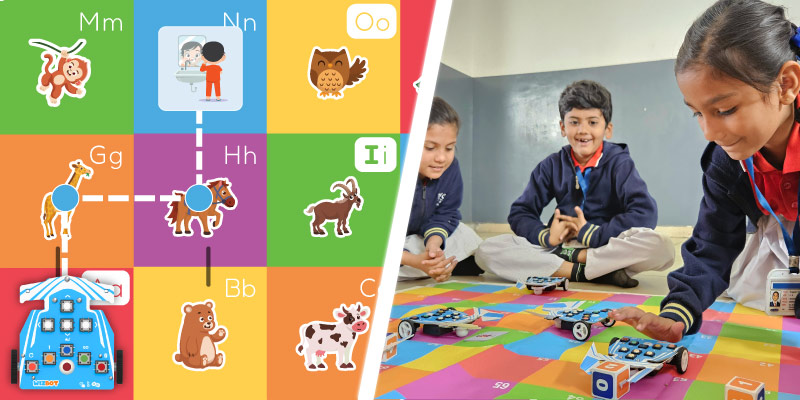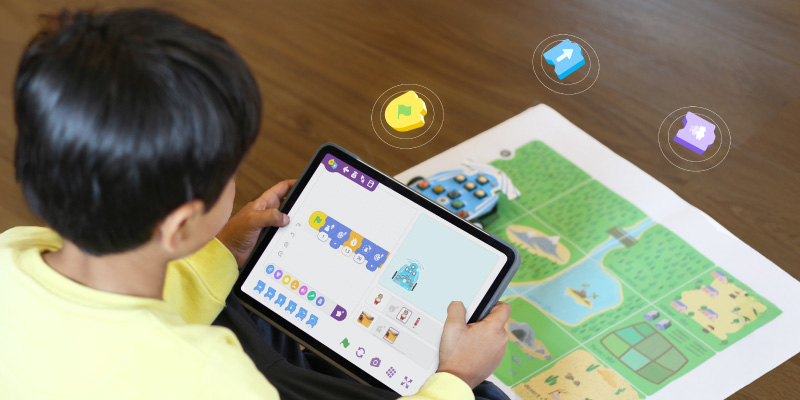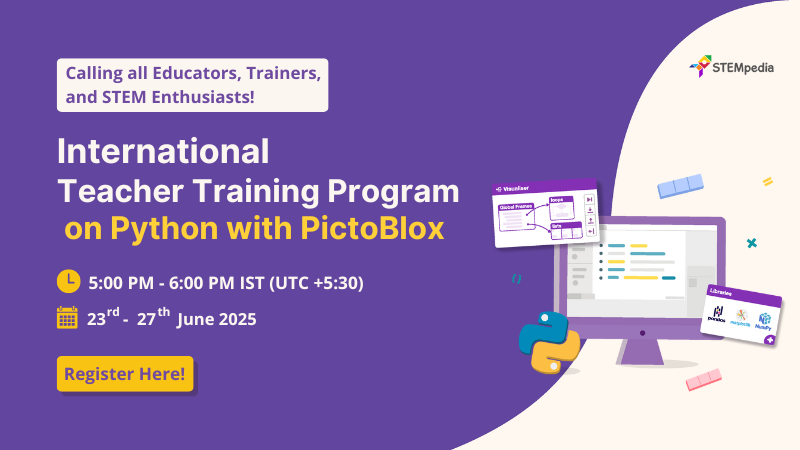The Haryana Education Department, in collaboration with STEMpedia, launched a transformative initiative to establish STEM, AI, and Robotics Labs in 50 public schools across 13 districts. Officially initiated on April 1, 2024, this project goes beyond infrastructure; it introduces students to a future where technology meets tradition.
In these labs, students have brought ancient epics like the Mahabharata to life using robotics and built sensor-enabled tributes to local wrestling culture, proving that innovation comes to life when rooted in cultural identity.
The initiative is guided by the National Education Policy (NEP) 2020 and designed to foster 21st-century skills such as coding, tinkering, artificial intelligence, and robotics through inclusive, hands-on, and innovative pedagogy.
Project Overview: Building Future-Ready Classrooms
On April 1, 2024, the Haryana Education Department, in partnership with STEMpedia, launched a large-scale initiative to set up AI and Robotics Labs in 50 government schools across 13 districts. This project was designed to make schools future-ready by integrating 21st-century skills such as Artificial Intelligence, Robotics, and Coding into the school curriculum.
The initiative has reached more than 20,000 students from Classes 6 to 12, ensuring exposure to modern technology tools and hands-on learning. To support the implementation, over 150 teachers were trained to use the labs and deliver the curriculum effectively. This partnership sets a strong example of how government and private organisations can work together to improve the quality of education and bridge the digital divide.
| Metric | Outcome |
| Number of Schools | 50 Government Schools |
| Districts Covered | 13 Districts of Haryana |
| Target Grades | Classes 6 to 12 |
| Students Empowered | 20,000+ |
| Teachers Trained | 150+ |
| Project Launch Date | April 1, 2024 |
| Partners | Haryana Education Dept and STEMpedia |
Modern Lab Infrastructure for Hands-On STEM Learning
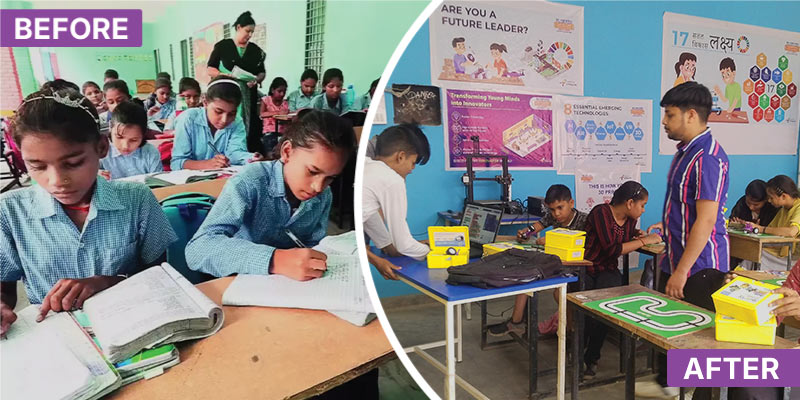
AI and Robotics Labs were established in all selected schools, with a clear focus on hands-on, experiential learning aligned with the goals of NEP 2020.
- Tablets with Preloaded AI and Coding Software: Each lab was equipped with 16 tablets, pre-installed with PictoBlox, STEMpedia’s AI and coding platform. This allowed students to instantly begin working with beginner-friendly tools for AI, machine learning, and robotics.
- High-Speed Wi-Fi Access: All labs were connected to high-speed internet, enabling uninterrupted access to learning modules, coding uploads, and online collaboration.
- Educational Quarky Robotics Kits: Every lab received Quarky kits for building and programming intelligent robots, enabling students to apply their learning in real-world problem-solving contexts.
- Integrated Learning Management System (LMS): A structured LMS platform was deployed across all labs to help teachers deliver content, track student progress, and access digital resources efficiently.
- Optimal Lab Capacity: Labs were designed to support 30-40 students per session, utilising rotational timetables to ensure smooth operations without overcrowding.
The shift from traditional classrooms to innovative, technology-enabled labs was visible through before-and-after photographs, demonstrating a measurable upgrade in the learning environment and infrastructure.
Curriculum Integration and Implementation in Regional Language
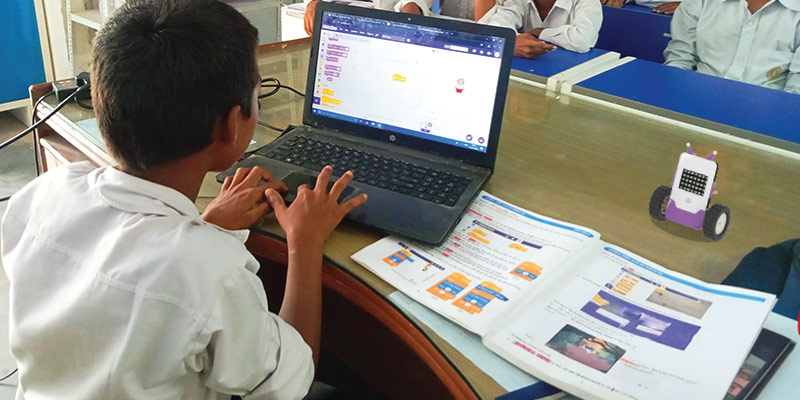
One of the most impactful components of the Haryana AI and Robotics Lab initiative is its structured integration of STEM into the regular school timetable, paired with a regional language-first approach. Together, they established a model of innovative pedagogy that is both inclusive and equitable, aligned with the vision of NEP 2020 and NIPUN Bharat.
- Curriculum Timetabled Across Grades 6-12
A carefully planned timetable assigned lab periods for every grade, from Classes 6 to 12, ensuring that all students had regular access without classroom overlaps or overcrowding.
Example: GSSS Sector 19, Panchkula’s timetable demonstrates how STEM periods are distributed throughout the week, maximizing lab usage and minimizing scheduling problems.
| Days | Periods | ||||||||
| 1 | 2 | 3 | 4 | 5 |
Lunch Break |
6 | 7 | 8 | |
| Monday | 12th C Deepa | 7th B Monica (Che) | 9th B Jyoti | 10th A Mamta Rani | 9th C Hitesh | ||||
| Tuesday | 11th D Anita | 8th B Sarbjeet | 7th D Monica (M) | 9th A Sarbjeet | |||||
| Wednesday | 7th A Yashwant | 7th C Gayatri | 8th A Mamta | ||||||
| Thursday | 12th D Anita | 12th B Rajvinder | 11th B Ravinder | 12th C Asha | |||||
| Friday | 9th D Hitesh | 10th D Sarbjeet | 10th B Jyoti | ||||||
| Saturday | 12th A Harneet | 8th C Jyoti | 9th E Monica (Che) | 10th C Monica (Che) | 11th A Mamta | ||||
- Subject-Specific Teacher Allocation
Teachers were assigned based on subject expertise to ensure focused guidance in AI, Robotics, and Coding. This subject-specialist model empowered students with deeper, domain-specific learning support.
(e.g., Monica – Chemistry, Sarbjeet – Robotics) - Regional Language Implementation at All Levels
All curriculum-aligned materials, including printed textbooks for students and instructional guides for teachers, were provided in Hindi, the regional language of Haryana. The material also includes digital content on PictoBlox to learn coding, AI, and robotics in a fun and interactive way. This removed barriers to understanding and empowered students to learn complex AI and coding concepts in a language they understood deeply. - Multilingual Readiness for Replication
The program model has been designed for easy adaptation across different states, allowing future implementations in regional languages such as Telugu, Marathi, or Gujarati. This makes it scalable, inclusive, and highly relevant for non-English-medium public schools. - Inclusive, Culturally Rooted Learning Materials
The curriculum enables students to apply 21st-century skills in meaningful, culturally connected ways by combining regional language with local cultural importance. Students are solving problems and expressing creativity in ways that reflect their communities and environment. This project is a seamless blend of tech, accessibility, and contextual relevance that transforms how students in public schools experience STEM learning, owing to the essence of innovative pedagogy.
Teacher Training and Capacity Building in STEM
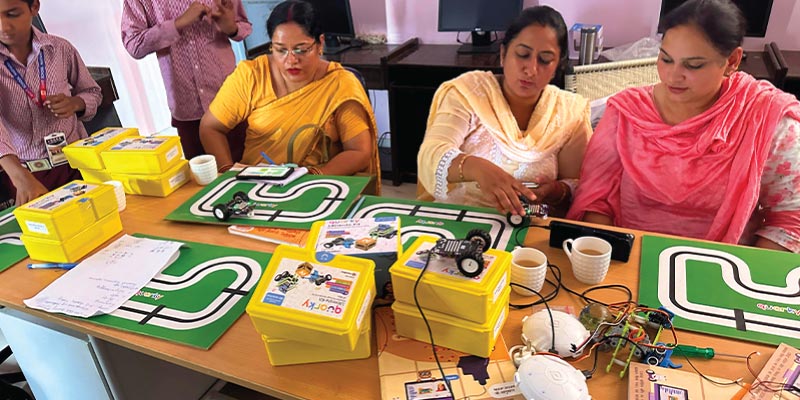
The Haryana AI and Robotics Lab initiative invested heavily in teacher training and institutional capacity building. This ensured that government school educators were not just users of technology, but confident facilitators of hands-on, future-ready learning.
- 150+ Government School Teachers Trained Across 50 Schools
An average of 3 teachers per school were trained, creating a sustainable human resource model to support rotational lab sessions across grades and subjects. - 3-Month Intensive Hands-On Training by STEMpedia
The training covered:- Hardware skills using Quarky robotics kits
- Software and AI pedagogy using PictoBlox
- Activity-based learning techniques, aligned with NEP 2020
- Troubleshooting, integration with the school timetable, and student project mentoring
- Continuous On-Ground Mentorship and Support
After the core training, teachers received weekly in-school mentoring visits and field-level technical support from STEMpedia’s implementation team, ensuring real-time assistance and confidence-building. - Access to Personalized Learning Management System (LMS)
Every trained teacher was onboarded to the LMS platform, providing:- Self-paced digital upskilling
- Ready-to-use lesson plans and tutorials
- Step-by-step teaching guides
- Student progress tracking and classroom analytics tools
- Empowering Teachers for Long-Term STEM Success
This capacity-building model enabled schools to run lab activities independently, support interdisciplinary projects, and scale student engagement without relying on external facilitators.
Student Innovation and AI Projects in Schools
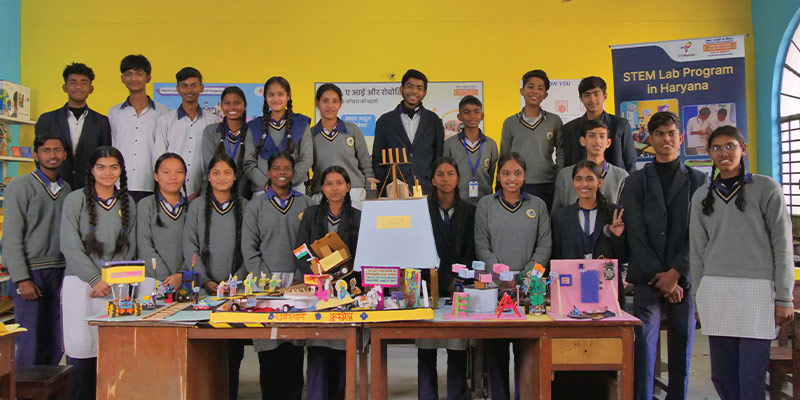
The Haryana AI and Robotics Lab initiative put experiential, hands-on learning at the center, allowing students to move beyond theory and actively build solutions grounded in their environment and culture. Students from Grades 6 to 12 were engaged in structured activities, culminating in original projects that combined technical skills with local relevance and social meaning.
Each student project was designed to reflect real-world application, empathy, and creative expression through AI and Robotics.
Selected Student Projects:
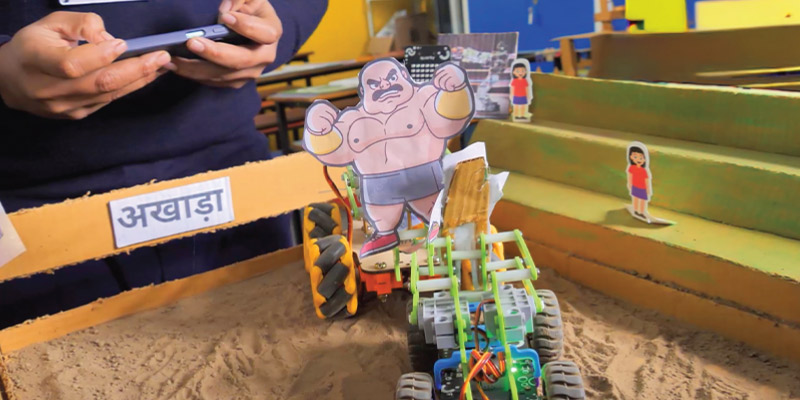 Robo Kushti – Paying homage to Haryana’s traditional wrestling culture, this project used sensors, RGB lighting, and thematic visuals to create a modernized, interactive version of a kushti match, merging heritage with technology.
Robo Kushti – Paying homage to Haryana’s traditional wrestling culture, this project used sensors, RGB lighting, and thematic visuals to create a modernized, interactive version of a kushti match, merging heritage with technology.
 Mahabharat at Kurukshetra – A storytelling innovation that dramatized episodes from Indian mythology using Quarky robots and PictoBlox animations, combining literature, history, and robotics for a compelling cultural presentation.
Mahabharat at Kurukshetra – A storytelling innovation that dramatized episodes from Indian mythology using Quarky robots and PictoBlox animations, combining literature, history, and robotics for a compelling cultural presentation.
- Weather Monitoring System – A student-built IoT project that used sensors to capture real-time weather data, teaching students how to integrate hardware and data-driven decision-making for community benefit.
- River Waste Collector Bots – Inspired by local concerns of river pollution, students designed mobile bots capable of simulating the collection of waste, reflecting eco-consciousness and problem-solving.
- Smart School Doors – An automation-focused project where students created doors with security sensors and voice alerts, addressing school safety while learning about sensors and real-time processing.
Gender Inclusion and Social Impact through STEM Education in Haryana Government Schools
The Haryana AI and Robotics Lab initiative placed a strong focus on equitable STEM access, aligning with the visions of Beti Bachao Beti Padhao, Digital India, and NEP 2020. The goal was not just to introduce technology but to break social and gender barriers in education.
Across 50 government schools in 13 districts, more than 20,000 students experienced hands-on AI and robotics education for the first time, many of them from rural and semi-urban communities.
- Of these, over 10,000 were girls, marking a significant breakthrough in STEM engagement among female students.
- Before the installation of STEM labs, schools typically saw only 7 to 10 girls participating in technology-related activities. Post-implementation, this number grew to 25- 30 girls regularly attending and engaging in AI and robotics sessions. This marked a threefold increase in girl student participation, underscoring the role of access, hands-on learning, and regional-language content in fostering inclusion.
- Overall, classroom engagement also rose significantly. Average participation per session across grades grew from around 15-20 students to over 35-40 students, with both boys and girls showing renewed interest in school attendance, particularly on lab days, and a noticeable increase in active involvement during hands-on activities.
This boost in participation wasn’t just about numbers; it was about transformation:
- Students with no prior exposure to STEM were now building projects involving:
- Sensor integration
- AI-based animations
- Cultural and environmental robotics, such as Robo Kushti and Smart School Doors
In several schools, girls emerged as team leaders, presenting innovations at district-level showcases, breaking stereotypes and proving that when empowered, every child can be a changemaker.
Educators reported a visible change in classroom dynamics: students who were once shy or hesitant, particularly girls, were now asking questions, experimenting confidently, and independently debugging code or assembling robots.
As one STEMpedia trainer shared,
“Girls in rural schools today are building robots. That’s the future we believe in.”
Through inclusive design and localized implementation, the initiative has not only closed gender gaps in access to technology but also created a model of social impact that is scalable and replicable for other regions
Student Exposure Through STEM Competitions: District to National Level
A structured competition framework was developed as part of the Haryana AI and Robotics Lab initiative to sustain student engagement, amplify innovation, and provide recognition at multiple levels. This ecosystem allowed students to grow from local problem-solvers to confident national-level participants.
Intra-School and District-Level Competitions
The journey began with intra-school and regional competitions, where students presented their AI and robotics projects within their schools. These internal showcases created a safe, supportive space for students to build confidence, receive feedback, and gain peer motivation.
From there, standout teams were invited to participate in district-level showcases held across the 13 participating districts. These state-level events were pivotal, as they:
- Brought together students from all 50 government schools, enabling cross-district collaboration and healthy competition.
- Featured real-world projects rooted in students’ local contexts—from sensor-enabled cultural storytelling to eco-robots for river waste collection and AI-based safety automation.
They were attended by education ministry delegates, government officials, parents, and school heads, creating a strong platform for public visibility and community pride.
Beyond competition, these events helped foster:
- A spirit of innovation and teamwork,
- Stronger presentation and communication skills, and
- A deeper sense of ownership in learning outcomes.
Codeavour 6.0 India Nationals: Bridging State Efforts with National Exposure
The most significant milestone came when students from these government schools advanced to Codeavour 6.0 India Nationals, India’s largest AI and Robotics championship for school students. Their participation represented not just talent, but the success of a public education transformation.
At Codeavour Nationals, Haryana’s students:
- Competed alongside peers from private institutions and schools across India,
- Presented solutions built using Quarky kits and PictoBlox, and
- Showcased their technical competency, creative problem-solving, and growth through structured exposure to AI and robotics.
For many students, particularly from rural and semi-urban regions, this was their first time on a national stage, gaining experience, confidence, and recognition that extended beyond their classrooms.
Community and Institutional Impact
This competition framework evolved into a sustained culture of innovation, reinforced by:
- Community participation and leadership endorsement at events,
- Renewed interest in STEM subjects among younger students, and
- Regular integration of project-making and exhibitions into school life.
By bridging grassroots participation with national recognition, the Haryana AI and Robotics initiative has empowered students not just to learn about the future but to actively shape it.
Monitoring, Evaluation, and Long-Term Sustainability
A comprehensive two-year monitoring and evaluation plan was established to ensure sustained impact and measurable outcomes across all 50 government schools.
- Structured data collection mechanisms were integrated from the start:
- Regular inputs were captured through the Learning Management System (LMS),
- Supplemented with field visits by the STEMpedia team, conducted at both school and district levels.
- Over 75+ periodic school visits were made during the first year alone, offering continuous academic and technical support to educators and students. These visits were used for:
- Troubleshooting lab operations,
- Gathering feedback from teachers and students,
- Tracking the integration of curriculum, usage of hardware/software, and student participation.
- A centralized reporting framework helped monitor milestones across labs, such as equipment usage, number of sessions held, attendance rates, and project submissions.
- Dashboards and visual tools were employed to provide real-time performance analytics, accessible to government stakeholders for transparent tracking.
- Photographic documentation, student project videos, and teacher observations were also collected to offer qualitative evidence of impact.
These continuous feedback loops ensured the program could adapt and evolve dynamically, keeping the model relevant, efficient, and scalable for replication in other states.
Conclusion: A Scalable Model for Educational Innovation
The Haryana AI and Robotics Lab project stands as a powerful example of how visionary policy, thoughtful technology integration, and local implementation can converge to redefine education. It translates NEP 2020’s aspirations into practical, daily classroom experiences. It transforms students from passive consumers into active creators. And it uses technology not as a gimmick, but as a meaningful tool for critical thinking, collaboration, and creativity.
As thousands of students across 50 government schools build robots, design solutions, and reimagine their surroundings, this initiative offers a replicable model for future-ready education, grounded in equity, empowerment, and innovation.
Key Impact Highlights from the Haryana AI & Robotics Initiative
Beyond numbers and milestones, the Haryana AI & Robotics Lab project revealed clear patterns of excellence that made it stand out. These recurring strengths underscore the thoughtful design and impactful execution behind the initiative
| Pattern | Description |
| Targeted Scheduling | Lab periods were intelligently slotted to ensure smooth, multi-grade participation without overlap. |
| Teacher Empowerment | Deep engagement through structured training and weekly mentoring visits for educators builds institutional capability. |
| Cultural-Technology Blend | Projects rooted in Haryana’s traditions and problems demonstrate powerful contextual learning. |
| Gender Empowerment in Tech | 10,000+ girls accessed AI, Robotics, and Coding, a transformative step for gender equity. |
| Transparent Deployment | From device allocation to infrastructure transformation, the project maintained transparency and accountability through meticulous documentation and visual records |


